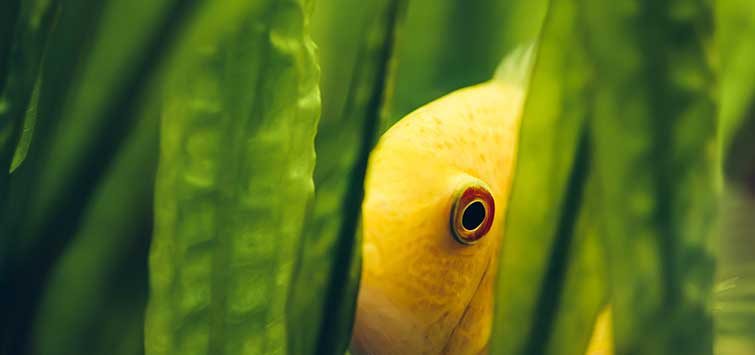The Planted Tank: Botany: An Introduction to Plant Biology, Part 2: Anatomy of a Plant
Author: Rhonda Wilson
Last month I gave a very brief review of botany from a historical perspective. Now that we have an idea of how this field of study developed, let’s look at how we describe plants.
EVOLUTION OF PLANT STRUCTURE
Originally, bacteria known as cyanobacteria or blue-green algae—which now sometimes invade our aquariums—developed the ability to photosynthesize. The algae were the next to evolve, and they eventually colonized freshwater environments. The first land plants evolved from freshwater algae (fossils of the spores from these early plants have been used to date this development, believed to have occurred 480 million years ago or more).
Mosses and liverworts, club mosses and horsetails, and ferns—all seedless vascular plants—were the next to evolve. Seed ferns (plants known by their fossils that may have been the link between the ferns and the seeded plants) and cycads, and the gymnosperms (cone-bearing plants) developed next. About 140 million years ago the first angiosperms appeared; these are the vascular, flowering, seeded plants. Their methods of reproduction were far superior to those of the plants that had evolved earlier, and they eventually became the dominant plants that they are now.
Until very recently there was a great deal of debate about the order of evolution and some of the groupings of the angiosperms. The two basic groups of flowering plants are the monocotyledons (monocots) and dicotyledons (dicots). The terms refer to the number of first leaves present (one or two), though there are also other features that distinguish the two. There are some plants, such as the water lilies, that confuse the issue by displaying both monocot and dicot features. Recent evidence from new scientific techniques has helped to clarify the relationships of these plants. It’s now believed that the dicots were in fact the first to develop, and the monocots evolved later from a dicotyledon ancestor.
TERMS FOR PLANT PARTS
The different types of plants that have evolved have some similarities and differences in the structure of their growth. The structures of a typical moss, fern, or angiosperm are different, so the various parts of these plants can have different names even if they look similar.
It's much easier to research information on aquatic plants if you're already familiar with the terminology; it's an absolute necessity if you're trying to identify a plant using a field guide or dichotomous key. A dichotomous key is a reference that gives a list of numbered paired choices to help you identify a particular organism. You simply choose which statement best describes the organism you're trying to identify, and at the end of that statement will be another number. You go to that number and then are given two more choices. This process repeats until the correct identification is reached.
MOSSES AND LIVERWORTS
We see mosses and liverworts in the aquarium quite a bit, and they have both increased in popularity in recent years, with many new mosses and a few new liverworts coming into the hobby. Mosses and liverworts have spores but not the protection of seeds. They’re also non-vascular, which means they don’t have an internal system of vessels to transport water and nutrients. These plants need to be in moist environments to live and reproduce.
Mosses don’t have true roots, though some have rhizoids that look very similar to them. Mosses also don’t have true leaves, though most people (including botanists) call them leaves. The technical term for the leaf-like structures on moss is phyllid. Some liverworts have leaf-like structures, but the liverworts we grow in our aquariums—generally Riccia and more recently Pellia—are simpler. These plants don’t really have much in the way of distinctive parts, and their stem and leaf-like structures are called the thallus.
FERNS
Club mosses, horsetails and ferns are more developed than the mosses and liverworts and have a vascular system. This allows them to grow larger and farther away from their water source. They still have a less developed reproduction system than the seeded plants, though, and they still need water for reproduction.
Water ferns, Java ferns, Bolbitis, Salvinia, and four-leaf clover are some of the common names of the aquatic ferns we grow in our tanks. Ferns have a rhizome and a root. The leaf-like part of a fern is called a frond. Some fronds are specialized to serve different functions; for example, what looks like roots hanging down from Salvinia are actually highly modified fronds. The parts of a more typical vegetative frond are: the stipe, which is the lower part of the stem, the rachis, which is the upper part of the stem where the more leafy parts of the fern grow out from, and finally those leafy parts which are called the pinna.
GYMNOSPERMS
I don’t believe there are any live gymnosperms used regularly in the aquarium, though I have heard of people growing cypress seedlings in open-topped tanks, and some folks use cypress wood in their aquascaping. Gymnosperms develop seeds in cones; those most common to us are pine, spruce, and fir trees.
ANGIOSPERMS
When looking at a plant, the parts we see first are the stems and leaves. The places on the stem where leaves and more stems grow is called a node. When cutting stemmed plants to root, this is also the place where new root growth will appear. The part of the stem in between the nodes is called the internode. When a stem grows along the substrate to form a new plant, then the stem is called a stolon. This occurs in plants such as Vallisneria, Sagittaria, and pygmy chain sword.
The leaf itself includes both the leaf stem, which is called a petiole, and the main part of the leaf, which is the blade or lamina. Leaves that don't have a petiole are called sessile, while those with one are petiolate. At the base of the petiole where it attaches to the stem are also one or more small axillary buds which can grow to form a new branch.
LEAF SHAPES
Leaves differ greatly in appearance and are a good first step in recognizing a plant, though some plants (particularly those for the aquarium) can have a very different looking leaf depending on the conditions in which the plant is grown.
An important part of the identification of a plant through the leaf is the pattern of its veins. There are three major venation patterns. In the pinnate pattern a main vein runs down the middle length of the lamina and smaller veins form on each side. Pinnate means that it resembles a feather, but I've always thought it looks like the midsection of a fish skeleton. Another type of venation is called palmate, which refers to the hand and the several large veins radiating from the base of the lamina. Think of a maple leaf and how the veins look like the spread fingers of a hand. The third type of venation is parallel, in which many veins run parallel down the length of the lamina. Parallel venation is a major feature of the monocots.
When looking at the shape of the leaf, the main shape, the shape of the tips and bases, and the shape of the edge of the leaf (called the margin) are considered.
Leaf shapes you’ll see often in aquatic-plant literature include lanceolate (long and tapered at the end like a lance), ovate (egg shaped), oblong (long oval shape with long sides parallel), elliptic (long oval shape with rounded long sides), cordate (heart shaped), and linear (very long and narrow).
Leaf shapes and margins are often mentioned together in literature, although sometimes only one is mentioned if it’s the distinguishing feature of a plant. Entire margins are smooth, serrate margins have a jagged teeth-like edge, and undulate margins are wavy. Oak trees (or in the case of aquarium plants, the Mexican oak plant) is a good example of a lobed leaf margin. Feathery leaves are described as pinnate, pinnatifid, or bipinnate. There are many aquarium plants that have developed these kinds of leaves.
COMPOUND LEAVES AND LEAF ARRANGEMENT
Some plants have multiple leaflets that grow on the petiole instead of single leaves. Plants with a single leaf per petiole are called simple leaves. When they have multiple leaflets they're called compound leaves. You can tell the difference between a compound leaf’s leaflet and a simple leaf by checking where the leaf attaches to the stem. If there is no axillary bud, then it's a leaflet and not a leaf. Compound leaves are pinnate when multiple leaflets grow opposite each other along a modified midvein that looks like a stem. This modified vein is called a rachis. When the end of the pinnate leaf ends in two leaflets, it's called even pinnate and when it ends in a single leaflet it's known as odd pinnate. Bipinnate leaves are further divided with leaflets on branches coming out the sides of the rachis. If four or more leaflets grow attached to the end of a petiole, it has a palmate compound leaf. If there are three leaflets, like in clover, it's called trifoliate.
Leaf arrangement is determined by how many leaves are at each node and how they grow. If there is a single leaf at each node the leaf arrangement is alternate. If there are two leaves at each node, they will grow across from each other and form an opposite leaf arrangement. Whorled leaf arrangements consist of three or more leaves at each node. Rosette plants grow leaves in a circular pattern. It looks like all the leaves are coming from the same place, but they actually have very, very close nodes, with almost no internode between them.
Adding a few more botany terms to your vocabulary can help you in making identification faster and easier. Hopefully it will also help you to have a deeper understanding of how complicated the underappreciated world of plants really is.

.png?h=595&iar=0&w=2781&hash=5FD5E69473BCC22199FBFA2FB71B6033)



